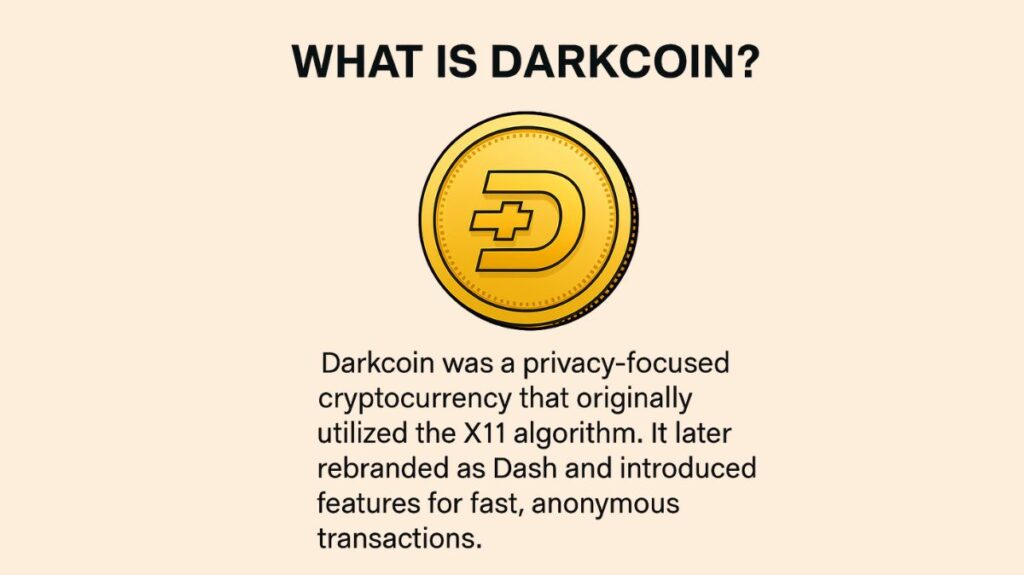What is darkcoin?

Darkcoin, now known as Dash, was launched in 2014 as a software fork of Bitcoin. Initially, it gained a less-than-reputable association because it was accepted as payment in online marketplaces that sold illicit goods.
Here’s an explanation of Darkcoin:
Emphasis on Privacy and Anonymity
- With an emphasis on characteristics that made transactions difficult to track, Darkcoin was created solely to protect user privacy and anonymity. These features that prioritized anonymity were reflected in its moniker, “Darkcoin.”
- It was regarded as an Anonymity Enhanced Cryptocurrency (AEC), much like Zcash and Monero.
You can also read Musicoin: A Blockchain Platform For The Artists And Fans
Key Features (Inherited by Dash)
Several changes were implemented by Darkcoin to rectify the perceived flaws in Bitcoin, namely, regarding transaction speed and privacy:
- PrivateSend (formerly Darksend): This feature mixes transactions from several users together to improve user privacy by making it far more difficult to track down the destination of payments. A better form of CoinJoin serves as its foundation, combining user input with that of at least two other people sending comparable amounts to a new address that the user controls. Different denominations go through this process in rounds. The fact that the master nodes involved in the mixing still know who is delivering what to whom, however, is a drawback of this technique and could expose it to tracking.
- InstantSend (formerly InstantX): Designed to provide near-instant transaction confirmations, often within seconds. Unlike Bitcoin, which can take several minutes for confirmation, InstantSend leverages a network of specialized servers called “masternodes” to quickly lock and confirm transactions.
- Decentralized Governance (Masternodes): Darkcoin was the first to introduce a two-tier network. Miners comprise the first layer, and “masternodes” comprise the second. Advanced capabilities like InstantSend and PrivateSend are made possible in large part by masternodes. Additionally, Dash is a Decentralized Autonomous Organization (DAO) since it uses a decentralized governance mechanism that lets the community vote on ideas for the project’s funding and progress. Running a masternode grants incentives and governance powers, but it also demands 1,000 DASH in collateral.
- The X11 Hashing Algorithm, which consists of a series of eleven distinct cryptographic hash functions, was first employed by Darkcoin for their Proof-of-Work system. Although specialized mining hardware (ASICs) gradually adapted to X11, this was intended to be more resilient to ASICs at the time, encouraging more decentralized mining. Using X11, mining a block took about two and a half minutes on average.
Association with the Dark Web and Rebranding
- Darkcoin was accepted as payment in online marketplaces that offered illegal products and found some success in dark web markets because of its strong emphasis on secrecy and anonymity. Experts linked it to terrorism financing and money laundering and thought it was used on the illicit market.
- This “dark” branding and its connotations hampered wider acceptance and repute. The cryptocurrency industry grew wary of dealings with Darkcoin as a result of these disputes, which resulted in its removal from several trading platforms.
- The initiative received a second rebranding in March 2015, becoming Dash, a portmanteau of “Digital Cash,” in an effort to break free from these unfavorable associations and increase its appeal. In order to transcend its initial “dark” reputation, this move sought to reflect its objective of being a useful cryptocurrency for daily usage, placing an emphasis on speed, anonymity, and usefulness. The “Darkcoin era” is currently seen as having ended.
Evolution into Dash
- As Dash, the cryptocurrency keeps developing with a robust governance scheme and community. Originally an anonymous token, it has evolved into a medium for commonplace transactions, creating a digital payment system that is both scalable and easy to use. In Venezuela, for instance, it has gained popularity as a “survival” strategy because of hyperinflation. In addition to financing a blockchain research center at Arizona State University, Dash developers are making research investments.
Darkcoin essentially functioned as a high-speed, covert transportation service for virtual currency. Its primary function was to transfer money swiftly and discreetly, even though its anonymity characteristics initially drew some users for covert purposes. This led to its development into Dash, which seeks to be a widely used, rapid, and easy-to-use digital currency for everyone.
Differences Between Darkcoin (Dash) and Bitcoin
| Feature | Bitcoin | Darkcoin / Dash |
|---|---|---|
| Privacy | Transparent | Optional via PrivateSend |
| Speed | ~10 mins/block | Seconds with InstantSend |
| Governance | None | Masternode-based DAO |
| Block Time | ~10 minutes | ~2.5 minutes |
| Coin Supply | 21 million | 18.9 million (approx) |
You can also read Proof of Humanity Blockchain: Verifying Unique People Online
